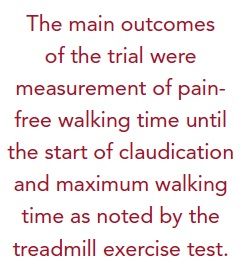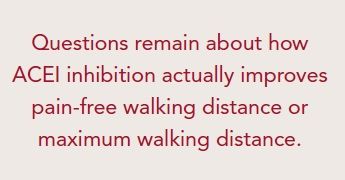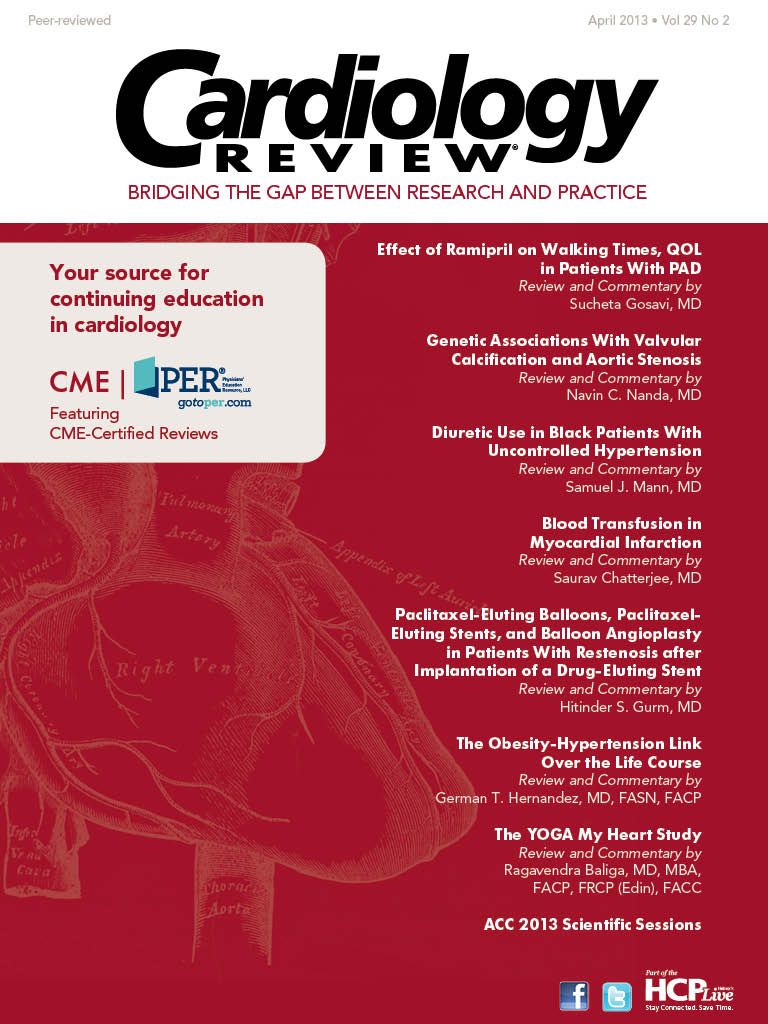Effect of Ramipril on Walking Times, QOL in Patients With PAD

Sucheta Gosavi, MD
Review
Ahimatos, AA, Walker PJ, Askew C, et al. Effect of ramipril on walking times and quality of life among patients with peripheral artery disease and intermittent claudication: a randomized controlled trial. JAMA. 2013;309:453-460.
Peripheral arterial disease (PAD) affects millions of people worldwide, and when present with intermittent claudication leads to functional disability. PAD has also been the cause of increased health care costs and death, comparable to coronary artery disease (CAD).

Over the last decade and a half, peripheral interventions and exercise have helped to improve some functional disability in PAD. To date, however, the only medications approved for PAD, pentoxyphylline and cilastozol, have not dramatically improved walking distance. Angiotensin-converting enzyme inhibitors (ACEIs) have been of great interest because data from previous trials suggest that they can improve walking time before intermittent claudication sets in.
The aim of this study was to investigate the influence of treatment with ramipril for 24 weeks on patients with PAD with diabetes mellitus (DM) and aortoiliac and infrainguinal disease, specifically on walking distance and health-related quality of life (QOL). The study was performed in Melbourne, Townsville, and Brisbane, Australia, between May 10, 2008, and August 23, 2011.
Study Details
The study was a randomized, doubleblinded controlled trial with no crossover in which subjects were either taking ramipril 10 mg/d orally or a placebo orally. Medication adherence was measured by monthly pill counts. Adverse event documentation, blood biochemistries, measuring vital signs, and physical examination at 3 and 6 months were done for safety monitoring during the trial.
The inclusion criteria for patients were ankle brachial index (ABI) <0.90 at rest in at least 1 leg and history of stable intermittent claudication in 1 or both legs. The subjects had to be on the study medications for at least 24 weeks. Statins and antiplatelet therapy, if needed, were continued during the study. Subjects who were already on ACEIs or angiotensin receptor blockers (ARBs) were excluded. Other criteria for exclusion were blood pressure >160/100 mm Hg, currently taking potassium- sparing diuretics, potassium supplements 6 months prior to enrollment, renal failure with creatinine >2.3 mg/dL, renal artery stenosis, coronary or lower extremity interventions, myocardial infarction in last 3 months, critical limb ischemia, major surgery planned in near future, and conditions such as chronic obstructive lung disease, CAD, and musculoskeletal weakness that would limit walking ability.
The main outcomes of the trial were measurement of pain-free walking time until the start of claudication and maximum walking time as noted by the treadmill exercise test. Other parameters assessed were ABI both at rest and post-exercise, severity of arterial stenosis by Duplex ultrasound, functional status on the walking impaired questionnaire (WIQ) (self-reported limitations on walking distance, walking speed, and climbing stairs on a scale of 0 to 100, where higher scores meant fewer symptoms and more functional capacity), and health-related QOL assessed by Short Form 36 (SF-36), which measures the degree of disability depending on physical and mental components.

Of the 921 subjects screened, 212 fulfilled all study criteria and were randomized into 2 groups of 106 each, receiving either ramipril 10 mg/d orally or placebo. Baseline characteristics in both groups were similar for all baseline parameters. There were more current smokers in the ramipril group compared with the placebo group (39 vs 32). Nearly equal numbers of subjects in both groups were taking aspirin, cilastozol, statins, and ß-blockers; however, there were 38 patients in the ramipril group who were taking clopidogrel and 21 in the placebo group.
At 6 months, investigators found a significant 75-second (77%) increase in painfree walking time (P <0.001; 95% confidence interval [CI], 60-89 seconds) and 255-second (123%) increase in maximum walking time by treadmill test in subjects receiving ramipril (P <0.001; 95% CI, 215-294 seconds). Results were similar in subjects with blood pressure above and below 140/90 mm Hg. There was a significant decrease in both systolic and diastolic blood pressure and a small but significant change in ABI, both at rest and post-exercise, in the ramipril group. Duplex ultrasound was performed in 45% of the placebo group and 61% of the ramipril group. The ramipril group showed a significant increase in flow 63 mL/min above the site of stenosis, but no change at the site of stenosis was noted in either group. No significant change was seen in the common femoral artery diameter at the site of stenosis or above it in either group. The WIQ score was increased in all 3 categories: median walking distance, speed score, and stair climbing, which increased by 13.8, 13.3, and 25, respectively, in the ramipril group. Although ramipril did not cause a change in the mental component of SF-36, there was some, though not statistically significant, improvement in the median physical component summary score.
Commentary Casting Light on the Importance of Medication in PAD
This study has further illuminated the importance of medications for the treatment of PAD due to its high burden of morbidity and mortality and its association with increased risk of stroke and CAD. It has basically confirmed the results of a smaller 2006 study of ramipril by Ahimatos and colleagues,1 in which patients with hypertension and DM were not enrolled. In the present study, patients who smoke and patients with DM, hypertension, and dyslipidemia—the major causes of PAD—were present in both study groups. Ramipril again demonstrated improved results in pain-free walking time, maximum walking time, and increased ABI. Lowering blood pressure with ramipril did not change the outcomes because improvement was seen in both the normotensive and hypertensive groups.
There has been a great deal of interest in the effects of different ACEIs on CAD, cerebrovascular disease (CVD), and PAD. Studies have shown no change in pain-free or maximum walking distance (with fosinopril)2 or increase in physical functional capacity in elderly patients (with 6 months of perindopril).3 Patients taking perindopril had normal left ventricular systolic function without heart failure, though they had age-related atherosclerosis and showed increased functional performance similar to 6 months of exercise training.
Questions remain about how ACEI inhibition actually improves pain-free walking distance or maximum walking distance. Decreasing atherosclerosis, increasing blood flow in skeletal muscles, angiogenesis, or improvement of endothelial dysfunction by increased expression of vascular endothelial growth factor are some of the likely modes of action. A review of the literature showed that quinapril 20 mg/d in the QUIET4 study and enalapril 10 mg twice daily in the SCAT5 trial showed no effect on the rate of progression of atherosclerosis (risk factors did not include DM but did include CAD). However, the study by Hosomi et al,6 in which subjects had DM as well as CAD, found a 49% reduction in the rate of atherosclerosis progression with enalapril 10 mg/d. Ramipril 5 to 10 mg/d in the PART-27 study did not show much effect in reducing the rate of progression of atherosclerosis, but a 37% reduction in the rate of atherosclerosis progression was noted in the SECURE8 trial, in which ramipril 10 mg/d was administered to patients with CAD, PAD, DM, or prior stroke. It remains to be seen whether ramipril is better than other ACEIs in the treatment of PAD and whether the results are dose dependent.

Exercise training is one of the major treatments for PAD but is limited by intermittent claudication. The Health ABC9 trial showed that older subjects on ACEIs have larger lower-extremity skeletal muscle mass than those taking other antihypertensive medications, which can be one of the causes of improved physical performance. Markers of endothelial dysfunction may give an insight into ramipril’s mechanism of action in improving outcomes in PAD. The HOPE10 trial showed a decreased risk of developing urinary microalbuminuria and clinical proteinuria in subjects with and without DM. Would measuring urinary microalbumin levels, C-reactive protein, and other markers of endothelial dysfunction at baseline and at 6 months indicate improving endothelial dysfunction that results in improved physical performance? ACEIs have also been shown to decrease arterial stiffness by decreasing collagen deposition and increasing fibrillin-1 production in the vascular wall,11 which may result in increasing blood flow and improving functional response.
There were more participants taking clopidogrel in the ramipril group than in the placebo group, some of whom were also taking aspirin. Whether the dual therapy contributed to improving ABI, which was significantly increased in the ramipril group, is not known. Previous studies by Gardner and Montgomery12 and Amoh-Tonto13 showed that increased ABI does not correlate well with increasing walking distance. The study by Parmenter et al14 has also shown that increased ABI after revascularization is not consistently associated with increased functional performance and walking distance.
One of the major advantages of this study was that it was a double-blind, controlled randomized trial. With few FDA-approved drugs available for alleviation of PAD symptoms, the addition of ramipril therapy would be highly desirable. It would be interesting to see if ramipril versus exercise training for 6 months and/or ramipril versus other ACEIs/ARBs have comparable results in PAD patients, and whether they continue to improve physical function after 6 months or remain stable.
References
1. Ahimatos AA, Lawler A, Reid CM, Blombery PA, Kingwell BA. Brief communication: ramipril markedly improves walking ability in patients with peripheral arterial disease: a randomized trial. Ann Intern Med. 2006;144:660-664.
2. Cesari M, Pedone C, Incalzi RA, Pahor M. ACE-inhibition and physical function: results from the trial of Angiotensin Converting Enzyme Inhibition and Novel Cardiovascular Risk Factor (TRAIN) study. J Am Med Dir Assoc. 2010;11:26. doi: 10.1016/j.jamda. 2009.09.014.
3. Sukumadas D, Witham MD, Struthers AD, McMurdo MET. Effect of perindopril on physical function in elderly people with functional impairment: a randomized controlled trial. Can Med Assoc J. 2007;177:867-874.
4. Cashin-Hemphill L, Holmvang G, Chan RC, et al for the QUIET investigators. Angiotension converting enzyme inhibition as antiantherosclerotic therapy: no answer yet. Quinapril Ischemic Event Trial (QUIET). Am J Cardiol. 1999;83:43-47.
5. Teo KK, Burton JR, Buller CE, et al. Long term effects of cholesterol lowering and angiotensin- converting enzyme inhibition on coronary atherosclerosis: the Simvastatin/Enalapril Coronary Atherosclerosis Trial (SCAT). Circulation. 2000;102:1748-1754.
6. Hosomi N, Mizushige K, Ohyama H, et al. Angiotensin-converting enzyme inhibition with enalapril slows progressive intima-media thickening of the common carotid artery in patients with non-insulin-dependent diabetes mellitus. Stroke. 2001;32:1539-1545.
7. MacMohan S, Sharpe N, Gamble G, et al for the PART-2 Collaborative Research Group. Randomized, placebo-controlled trial of the angiotensin converting enzyme inhibitor, ramipril, in patients with coronary or occlusive arterial disease: prevention of Atherosclerosis with Ramipril Trial (PART-2). J Am Coll Cardiol. 2000;36:438-443.
8. Lonn E, Yusuf S, Dzavik V, et al. Effects of ramipril and of vitamin E on atherosclerosis: the Study to Evaluate Carotid Ultrasound Changes in patients treated with ramipril and vitamin E (SECURE). Circulation. 2001;103:929-925.
9. Di Bari M, van de Poll-Franse LV, Onder G, et al. Antihypertensive medications and differences in muscle mass in older persons: the Health, Aging and Body Composition Study. J Am Geriatr Soc. 2004;52:961-966.
10. Yusuf S, Sleight P, Pogue J, et al for the Heart Outcomes Prevention Evaluation Study investigators. Effect of an angiotensin-converting enzyme inhibitor, ramipril, on cardiovascular events in high-risk patients. N Engl J Med. 2000;342:145-153.
11. Ahimatos AA, Natoli A, Lawler A, et al. Ramipril reduceds large-artery stiffness in peripheral arterial disease and promotes elastogenic remodeling in cell culture. Hypertension. 2005;45:1194-1199.
12. Gardner AW, Montgomery PS. The effect of metabolic syndrome components on exercise performances in patients with intermittent claudication. J Vasc Surg. 2008;47:1251-1258.
13. Amoh-Tonto CA, Malik AR, Kondragunta V, Ali Z, Kullu IJ. Brachial-ankle pulse wave velocity is associated with walking distance in patients referred for peripheral arterial disease evaluation. Atherosclerosis. 2009:206;173-178.
14. Paramenter BJ, Raymond J, Fiatarone Singh MA. The effect of exercise on hemodynamics in intermittent claudication: a systemic review of randomized controlled trials. Sports Med. 2010;40:433-477.
About the Author
Sucheta Gosavi, MD, is Assistant Professor of Internal Medicine at Texas Tech University Health Sciences Center in El Paso, TX. She is board certified in internal medicine and echocardiography. Dr. Gosavi received her medical degree at R.G. Kar Medical College in Kolkata, India. She completed her postgraduate studies in internal medicine in India and at the University of Missouri Columbia. Dr. Gosavi was a research fellow at Massachusetts General Hospital in the cardiac ultrasound laboratory. She also has a master’s degree in tropical medicine and public health.
